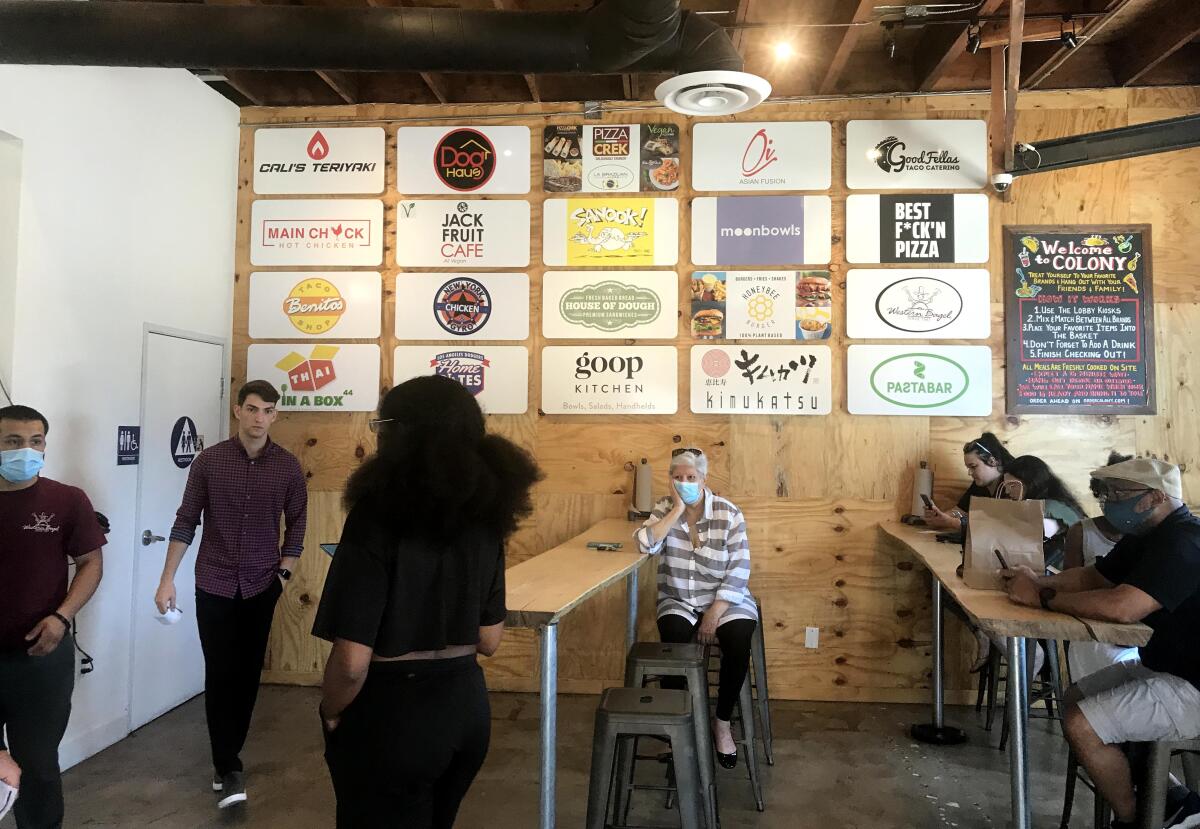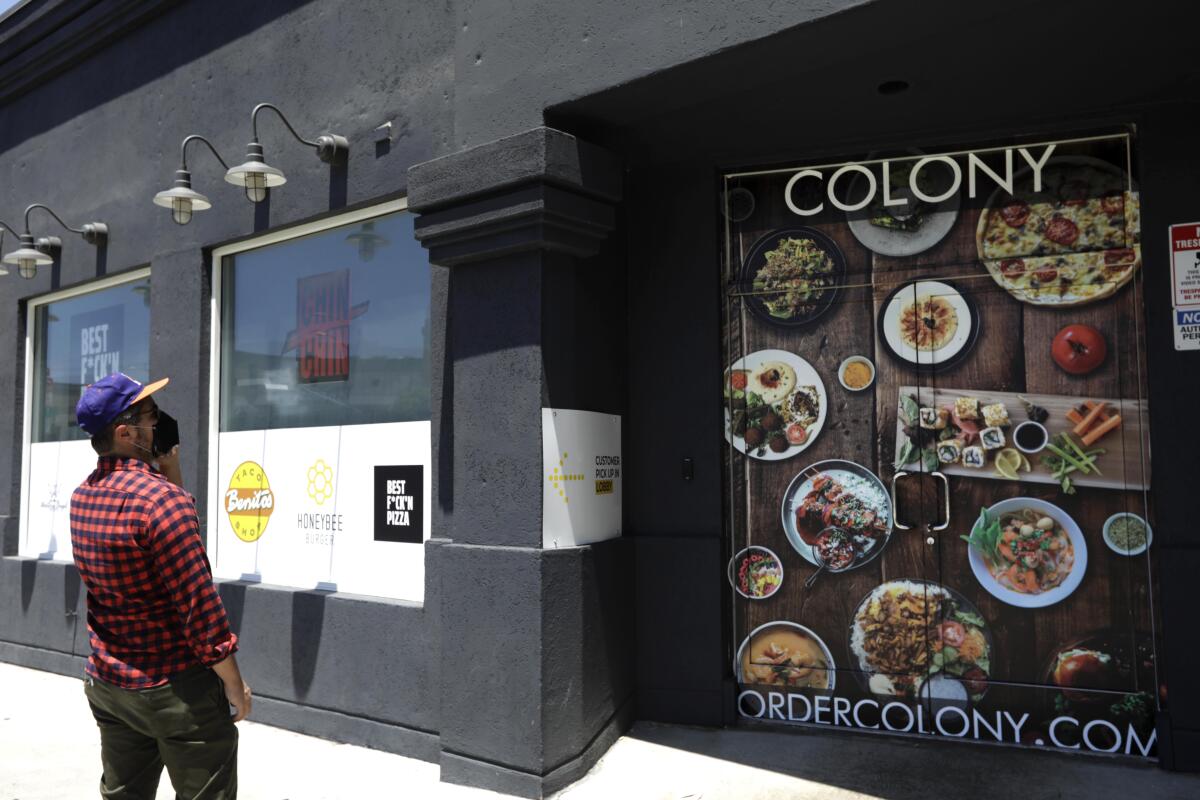Virtual restaurants and the ghost of California burritos past

- Share via
For the last decade or so, Benito’s Taco Shop on Santa Monica Boulevard has been my favorite California burrito spot on the west side.
It’s my go-to, not necessarily because it’s the best-tasting or fanciest burrito, but because it’s the burrito that’s been there for me time and time again.
Benito’s has rescued many a night with the simple virtue of being open until 3 a.m. And though I’ve since had better burritos, I still find its California burrito delicious, with a toothy, slightly translucent flour tortilla, tender carne asada and the option to substitute fries for potatoes.
A few weeks ago I called and placed my regular order, a California burrito and three rolled tacos.
But when I drove down Santa Monica Boulevard, the familiar yellow and orange Benito’s sign was nowhere to be found. I checked Yelp and found that the page was still active, even listing photos of the storefront and a Santa Monica Boulevard address.
I started to become very alarmed. I careened into a parking spot and began to pace frantically up and down the block, flip-flops flapping, sweat pouring and my heart thumping. Surely they had just changed locations, I thought. Please, not my Benito’s, too.

The truth was a bit harder to swallow. Benito’s had closed its brick-and-mortar location awhile back and relocated to a ghost kitchen inside a building calling itself Colony, a former Ethan Allen furniture space converted to kitchen facilities and a dining patio. As for the Benito’s sign, I finally located it on a far wall.
It was displayed with more than a dozen other brands in a grid of rounded squares that hauntingly recalled the app icons of a smartphone home screen.
Colony, I learned, is an example of a new evolution in commercial real estate called a ghost kitchen, also known as a cloud or virtual kitchen. There are at least two in Los Angeles and one in Pasadena. Each facility is divided into several kitchen spaces and dozens of brands, both virtual-only and established brick-and-mortar places like Canter’s, serve food out of a single space.
Ghost kitchens allow restaurateurs to create brands without having to go through the expensive and time-consuming process of finding a space. Existing restaurant brands can also spin off new brands with far fewer startup costs. My colleague Roger Vincent chronicled the rise a few months ago, noting that ghost kitchens can cost as little as $20,000 to establish and rent for as low as $5,000 a month.
In Pasadena, Eats on Madison offers a dizzying array of food options out of a single space, including but not limited to barbecue, pizza, kabobs, tacos, burgers, musubi, sub sandwiches, burritos, wings, acai bowls and more.
Each brand must register with the city as its own business and apply for a shared kitchen permit, said Rachel Janbek, manager of the Pasadena Environmental Health Division. Each brand also receives an individual food inspection and pays its own taxes.
Cloud kitchens allow chefs and business owners flexibility by reducing startup costs, said Blake Kaplan, a retail broker with JLL who has worked with cloud kitchens. The pandemic’s lockdown conditions have created delivery and takeout habits that may not change even with vaccines and reopening.
According to an International Foodservice Manufacturer’s Assn. study of delivery habits done in 201`7, 21% of my generation, millennials, orders delivery at least three times a week. Among Gen Z, the proportion is 24%.
A CBRE report estimates that ghost kitchens will account for 21% of total restaurant sales by 2025. Online food ordering business is expected to grow by 64% over that same time period.
Ghost kitchens are supposed to help restaurants respond to these changed conditions by lowering startup costs and encouraging entrepreneurship and innovation, said Jim Crocenzi, an advisor with CBRE who focuses on restaurant retail. Ghost kitchens can launch new restaurants in as little as two weeks, while brick-and-mortar restaurants often take more than a year to get off the ground.
But I can’t help but worry for these brick-and-mortar spaces, which to me are an essential, undervalued component of the life of a city. After nearly two years of lockdown conditions, we are all now intimately familiar with how lonely and barren life can be without these spaces to mingle and interact.
With the city and state reopening, many of us are reveling in the taste of food — any food — that did not spend 45 minutes in a Styrofoam container. We are rediscovering the joys of meeting in person at beloved bars, restaurants and cafes. We are learning that a city is more than the things you can buy — it’s the places you go and the people you can meet.
And now, these brick-and-mortar spaces face competition with entirely virtual brands that have much lower costs and much higher flexibility. On a delivery app listing, it’s impossible to tell which brands are brick and mortar and which exist only online.
I decided to go ahead and try the burrito. My phone order at Order Colony didn’t end up going through. An employee told me to get in line and reenter the order on an iPad.
And so there I was, another vacant face in a line of millennials dressed in pajamas or workout clothes, all of us staring at their iPhones as we waited to enter our orders on a smudged tablet. It was a grim look at what a future entirely shaped by the desires of my generation might look like. Or at least, what a private equity or venture capital firm interprets our desires to be based on the data collected from our social feeds.
What if delivery and takeout market share grow to the point that running a brick-and-mortar restaurant is unsustainable, or so expensive that only wealthy patrons can afford to dine in? What if the most profitable use of our city’s buildings becomes a staging ground for some still-unborn online juggernaut? What if Instagram traffic replaces foot traffic? What if another pandemic accelerates these evolutions and makes them permanent? This city wouldn’t be the same.
The ghost kitchen version of the burrito I’ve eaten for more than a decade finally arrived. I ate it at home over my coffee table, as I’ve taken most meals in this pandemic. The food tasted like I remember — the tortilla was nice and chewy, and the rolled tacos were drowning in guacamole and orange cheese.
I couldn’t shake the feeling that I’d been tricked. But in the end I was just glad the burrito still existed.
More to Read
Sign up for Essential California
The most important California stories and recommendations in your inbox every morning.
You may occasionally receive promotional content from the Los Angeles Times.














